|
Monday, February 22, 2010
Progress Notes
We were honored recently to have received two historical electrical panels from Ameren UE of Lake Ozark to accompany the large photographic UE display depicting the construction of Bagnell Dam already present in our museum. Alan Sullivan, Ameren UE consulting engineer, called me to offer us the panels as they were being replaced having been in use since 1930 when the power plant at the Dam was activated. Alan and Randy Stafford, also on the staff at Ameren, personally delivered the panels to us and did the heavy lifting as well (photo 01)!
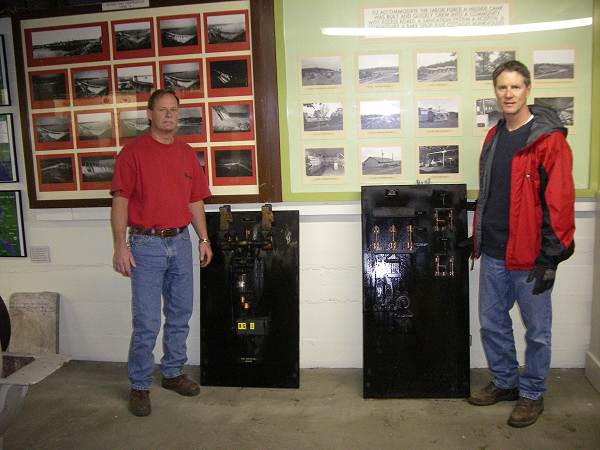
01 Randy Stafford and Alan Sullivan For those who are informed about the electrical equipment utilized in power generating facilities Alan sent me technical description of each panel. For guidance in identifying the panels, the one by which Randy is standing is identified as an ACB panel and it is labeled with the yellow HG1 sticker which is located on the lower half of the front of the panel.
The panel by which Alan is standing is called a Triple Pole Switch; you can identify the triple legged switch in the upper left of the panel.
And here is Alan’s short narrative describing these two panels:
1. The ACB panel is labeled HG1
2. The triple pole switch has three labels
Unit Exciter (top label)
Generator Field (middle label)
Emerg Excitation (bottom label)
Here is a description of each panel and its function in the power plant:
Air Circuit Breaker (called an “ACB” in power plant terms)
This ACB was originally installed at Bagnell Dam in 1930 on House Unit 2 and remained in operation until 2009, when it was removed and replaced with modern equipment.
The ACB is an electrical switch that would be closed by plant operators to allow the flow of electrical energy from a DC generator called an “Exciter” to the generator rotor (field).This energy flow is called “Excitation”. Plant operators increased excitation thus building the magnetic field strength in the generator rotor, which would in turn build the AC voltage in the electrical generator. When the AC generator voltage matched the line voltage of the surrounding electrical system, another switch would close and the generator would be producing electrical power.
Triple Pole Switch
This Triple Pole Switch was originally installed at Bagnell Dam in 1930 and remained in operation until 2009, when it was removed and replaced with modern equipment.
The Triple Pole Switch was normally placed in the up position to select Excitation energy from the unit exciter mounted on the House Unit main shaft. If the unit exciter was out of service, the switch could be placed in the down position, and would then receive excitation energy from a spare exciter, located elsewhere in the power plant.
Here are a couple more photos of electrical equipment taken in the power generating area (photos 02 and 03):
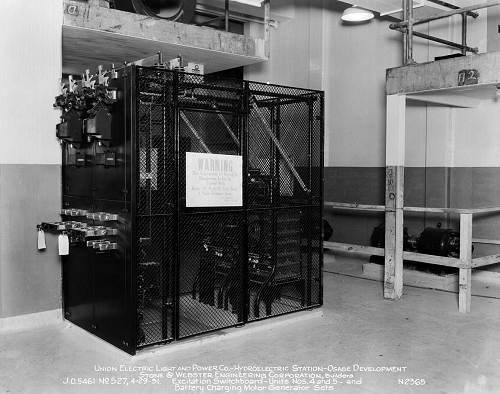
02 Excitation Switch Board Units

03 Extra Platforms
Thank you Alan for this very interesting addition to our AmerenUE display at the museum.
The electrical panels make a significant addition to our AmerenUE collection at the museum. Other items donated by AmerenUE include a serial photo display of the dam construction, which covers ninety feet of the west wall of our lower level; a number of tools and machinery; and items from the medical clinic established for the care of the workers during the dam construction.
All of us have been very proud of Alan who is a native of Tuscumbia having been born and raised here and is a Tuscumbia school graduate. He has been associated with AmerenUE for 33 years now and was one of the key organizers of the celebration of Bagnell Dam’s 75th anniversary three and one half years ago in 2006. Of course, as everyone here in Tuscumbia remembers, the highlight of the celebration for Miller County people was that Lloyd Slone (photo 04), Alan’s uncle, was honored for being the last living employee of those workers associated with the building of the dam.
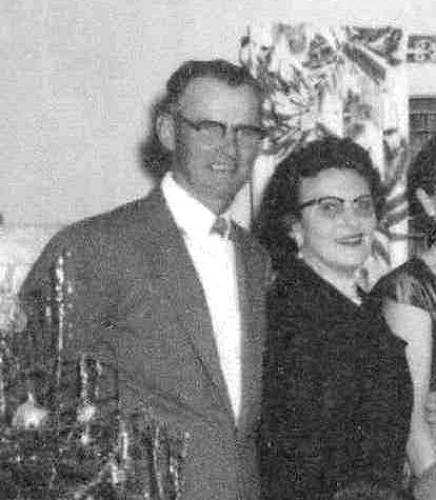
04 Lloyd and Wilma Slone The story was so interesting that Alan’s Uncle Lloyd was featured in newspapers far and away from here. Copied here is one of the articles written:
It's a Big Birthday
By Tom Uhlenbrock
ST. LOUIS POST-DISPATCH
Saturday, Apr. 29 2006
LAKE OZARK, MO. • Lloyd Slone recalled the morning more than 75 years ago when he showed up to land a job on what would be the Great Depression’s largest construction project — building Bagnell Dam across the Osage River.
“Daylight come, you couldn’t see the end of the line,” said Slone, now 93.
“People tried to get ahead of you; fights broke out. They were fighting for jobs.”
The year was 1929, and although he was just 17, Slone held his own in the skirmishes and attracted the attention of the hiring boss. He got a job cutting brush, directing mule teams — anything he could to earn his pay.
“You were supposed to be 18 to get hired. I was 18 on that day,” he said with a smile.
Bagnell Dam was completed in just 22 months, a phenomenal accomplishment that would be hard to duplicate even in modern times. Some 20,500 workers were employed on the project, and Slone may be the last one standing.
“He’s the last living worker on the dam as far as we know,” said Alan Sullivan, consulting engineer with AmerenUE, the owner of the dam and the land beneath the 54,000-acre Lake of the Ozarks. Sullivan, who is Slone’s nephew, has worked at the dam for 29 years and said his uncle prides himself in saying his work gave the boy a job.
“I found his and my grandpa’s name (Elmer Slone) on an old payroll book,” Sullivan said.
“They were paid 35 cents an hour and there were deductions for room and board in the bunkhouse.”
Slone lives in Eldon at an assisted-care home, where he met Sylvia, his wife of three years. “Saw her from all the way across the dining room. I said, ‘Boy, I’ve got to meet that gal.’ I had to get to work.”
Sylvia has her own version of love at first sight: “Lloyd’s kind of lost his eyesight, and I have a car.”
Bagnell Dam will celebrate its 75th anniversary this summer, and a lot has changed over the years. The dam still produces electricity through water power, providing pollution-free energy that is especially important during peak usage periods. But the community that grew up around the lake has evolved from a sleepy fishing destination to a small city of designer outlet malls (110 top names), signature golf courses (17) and pricey vacation homes (some rent for $1,100 a day).
Note: Lloyd passed away two years ago after this article was written.
For those who would want a review of the history of the construction of the dam, Carol Tellman Pilkington wrote a brief summary several years ago which I copy here:
The Great Osage River Project
The Great Osage River Project has been recognized as one of the greatest engineering and construction feats of its time. Site work began on August 6, 1929 by Union Electric Company of St. Louis, Missouri and the engineering corporation of Stone and Webster. The final price tag would be $30 million for the last and largest major dam to be built in the United States entirely with private capital. Four months after construction began, came the stock market crash followed by many years of the Great Depression. The gigantic undertaking created a gold rush type scene. News spread quickly and prospective employees began pouring into the area. They came by foot, on horseback, floating down the river, piled high in trucks, and a few in automobiles. The area was so remote that roads were dirt and the nearest railway stopped 15 miles away in Eldon. During the worst depression that the United States had ever seen, Union Electric created nearly 10,000 new jobs and, at that time, the largest man-made lake in the world. There were some 4,600 craftsmen and laborers working at one point in time, twenty-four hours per day and seven days per week. During the next two years, the project would see 20,500 workers come and go.
Until the Great Osage River Project was started, this land was sparsely populated. Most of the residents were settlers who came because of the 1864 Homestead Act. That Act would allow 160 acre tracts of land to be deeded, at $1.25 per acre, if the person lived on the land for five years. Union Electric created its own city. Dormitories and mess halls were the first built, followed by a commissary, hospital, a concrete plant, miles of roads, and even a jail for the rowdy misbehavers.
Using equipment that seems pretty crude now, the total construction was completed in just two and a half years. Crews worked daylight to dark and even 24 hours per day when it came to pouring concrete for the dam. A major phase of the construction was to build a 15 mile railroad from Eldon to a tiny town called Bagnell, located 5 miles below the dam. Several more miles of rail was built from Bagnell to the dam site and several spur lines to deliver millions of tons of material to stockpile areas. A railway and wagon bridge was constructed about 200 yards below the dam site to cross the Osage River to deliver to the steel yard and the concrete plant.
The mammoth project was divided into three major areas of activity. One part was the dam and power house. This also included all of the camps, constructing and maintaining roads, designing and building railways, and erecting a river bridge for rail, car, and wagons. Dozens of permanent and temporary structures were designed and fabricated. Many of the buildings are in use today, a full seventy years later. During low river water levels, wooden piers from the old bridge can still be seen. Steel pilings, girders, and cable are low river water hazards for boats and fishing lines. The dam is of concrete gravity type, 2543 feet long supporting a 20 foot wide roadway and three foot wide sidewalk. The power station is 511 feet long and the flood control spillway section is 520 feet long. The power plant produces 215,000 kilowatts mainly to the eastern part of Missouri and St. Louis.
A second portion of the undertaking was the electrical transmission lines to carry the generated power to the consumer. The third area of work was the water reservoir. This included surveying nearly 100 square miles, clearing thousands of trees that covered 30,000 acres, mapping the whole 100 square miles, and outlining where the shoreline would be. The reservoir covers 57,000 acres or 92 square miles, has nearly 1,375 miles of shoreline (more shoreline than the sea coast of the State of California), and impounds 617 billion gallons of water. The dam was completed and the Lake, as of then, unnamed began to fill on February 2, 1931. The Lake was opened to use May of 1931, only four months after it started filling and two years before the end of the Prohibition Act. There are many more pictures for the history buff.
List of Works Consulted
- Carole Tellman Pilkington, The Story of Bagnell Dam,Lake Area Chamber of Commerce,1989
- National Register of Historic Places, NPS form 10-900-a, Section 7
- Buford Foster, That’s The Way It Was, 1978
- T. Victor Jeffries, Before The Dam Water,1974
- AmerenUE, Bagnell Dam Construction Photos,1929-1931
- Video Productions Unlimited, Current Photos,1990's
Here are some photos which accompanied Carol’s article (photos 05, 06 and 07):
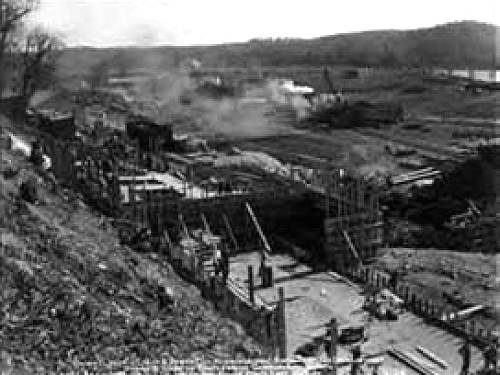
05 Dam Construction
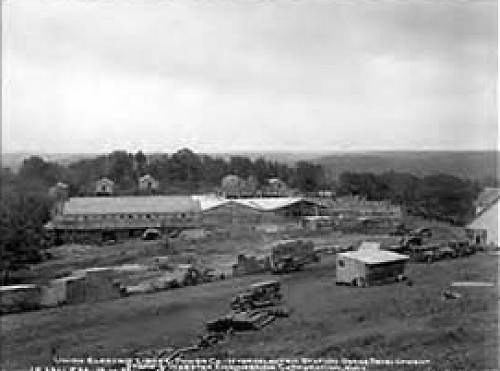
06 Dam Construction
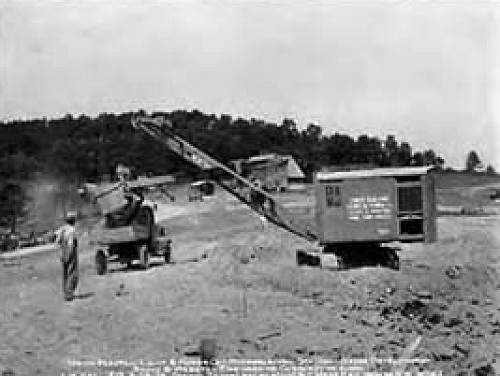
07 Dam Construction We now have available at the Missouri Digital Heritage website a location where you can view hundreds of photos of the construction of the Dam.
Here is an example of the quality of the photos on the Missouri Digital Heritage website (photos 08 and 09):
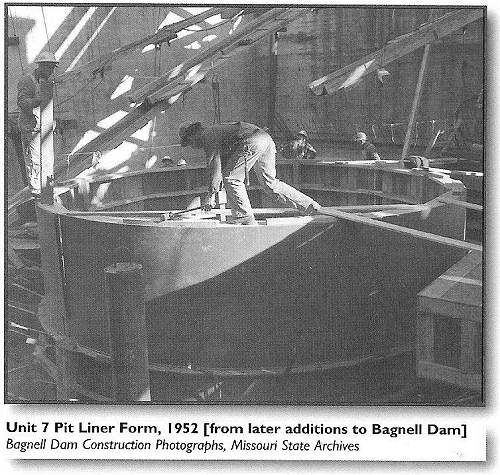
08 Generator Construction
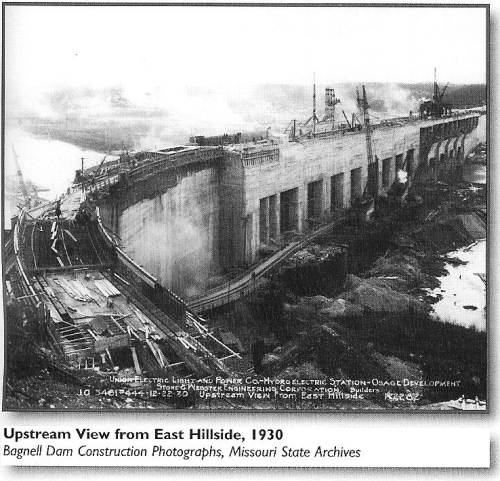
09 Bagnell Dam Early Construction So once again, we want to thank Alan Sullivan and AmerenUE for this important addition to our historical display of items depicting the history and importance of Bagnell Dam and AmerenUE to our county as well as the nation.
In the narrative above by Carol Pilkington, mention was made of the area downstream from Bagnell Dam where all the equipment and buildings were located for the dam construction. Just downstream from that area was a small village which sprang up as a consequence of the presence of so many workers who needed a place to live and stores to supply them with their daily needs. This area was known as “Dam Site” (photo 10).
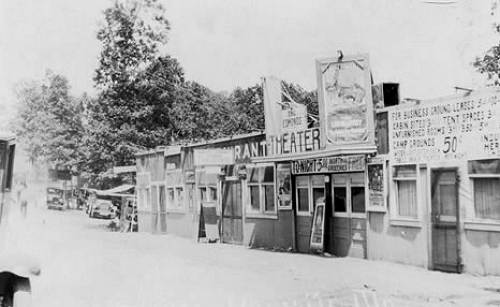
10 Dam Site - D. Weaver Today, nothing remains of all the equipment, shacks, tents, and small stores which made up the little town of Dam Site. You can see where it once was located when you cross the new Highway 54 four lane bridge across the Osage River by looking upstream toward the Dam. However, no trace of what was there before now is present. The person who best could describe Dam Site was Gaylord Strange, whose father and relatives owned much of the land where the little village was located (photo 11).

11 Gaylord Strange Sadly, Gaylord passed away a couple of years ago; however, I had the opportunity to chat with him on a number of occasions about various things including Dam Site. Gaylord was well known in the area for several reasons, one being that he was one of the maintenance employees at School of the Osage for quite a few years. Gaylord’s chief interest most of his life outside of his work was collecting newspaper articles from the local periodicals which recorded historical events and obituaries. He had shelf after shelf filled with three ring notebooks which contained photo copies of the many articles he preserved. Also, Gaylord made many censuses of Miller County cemeteries. He had almost a photographic memory of long ago events, in particular having to do with the area around Old Bagnell where he was born and raised. I and Nancy Thompson, museum director, as well as others visited Gaylord several times to obtain important records for our research room at the museum. He was always very eager to share with us information he had accumulated. Not long ago, he donated to the museum many of the files he had saved through the years.
Gaylord also wrote a narrative for our website about Dam Site.
This website also has a link to an article about Gaylord published in the Jefferson City Tribune newspaper as written by Ra'Vae Edwards June 6, 2007.
I obtained additional information about the history of Dam Site from Gaylord from one of his written narratives which I will copy here:
“The town of Dam Site was a boom town that existed during the building of the Bagnell Dam. It was located on the Henry Lemuel and Rebecca Strange property, which joined the Union Electric property on the east boundary line (Henry Lemuel was better known as Lemmie), they were my parents, and I was sixteen years of age. I was born in 1913 and spent a lot of time in the town of Dam Site.
The farm on which Dam Site was built was one mile east and down river from the Bagnell Dam and it extended one mile north. Its west property line and the east property line of Union Electric were the same, and just inside this property line was where the guard house and the employment office were located. So all the people who worked on the construction of the Bagnell Dam had to pass through the property of Lemmie Strange as this was the only road to the construction site. Because of this individuals came to Lemmie Strange wanting to lease land to build businesses and stores. The leases were usually for a period of three years with the option for renewal at their expiration date, but none was ever renewed as the construction on the dam was completed in less than three years.
On the south side of the road passing through Dam Site leading to the construction area was the J. and K. pool hall built by Leo Kirsch and Roy Johnson which was at the entrance to the Union Electric property. Next was the Storm’s Boarding House, then the Pepper Cabin Camp built by John Pepper, then the theater built by Mae Edmonds and then a filling station and garage operated by Harry Tanner. Next was the gravel pit leased by Hydro Electric where was obtained gravel for the roads built. This included the road which ran up the river bottom beside the railroad track heading toward the construction site.
On the north side of the road was a barber and shoe shop operated by Mr. and Mrs. Edwards, then a restaurant, a drug store and Post Office in the same building, a grocery store owned by W..R. Politte, and then a grocery and barber shop in adjoining buildings. The store was owned by a man by the name of Hall. Next was a newsstand owned by John Green and then a Bowling Alley owned by Mr. and Mrs. Goodman. All this was typical of a “boom town.” The story was that the bootleggers wore badges so as not to try to sell one another their wares.
A lot of people lived in tents also; in fact, the hills and valleys were full of tents for which people paid $3.00 per month for a place to put the tent.
All the guards and laws officers were Miller County deputy sheriffs with Harold J. Smith as Chief Deputy.
When you left Dam Site going east you entered Victor City in which there was the Taylor Grocer, Hall’s Cabins, and many other tents and cabins. Next was Spring Camp which was owned by Edgar Strange, a brother to Lemuel Strange. In it were the Atterberry brothers’ grocery store, a boarding house, and more tents and cabins. Next was the Conner Camp ground which was owned by William E. Conner who was a brother to Rebecca Strange. This campground had several cabins in it. These were located between the Union Electric property and the town of Bagnell.
That is the way I remember things while they were building the Dam; I was 16 years of age when the Dam was built, and a son of Lemuel and Rebecca Strange who owned the ground on which Dam Site was built.”
The following is information I obtained from Gaylord one day when I was visiting him. I had to write my notes quickly as he talked so if I am in error on the location of the farms he listed I welcome being informed:
Gaylord Strange was born about midway between Bagnell and Bagnell Dam and about l/4 mile east of where the Osage National Golf Course Club House is located.
His father, Henry Lemuel Strange, bought the farm from his wife's father, which was eighty acres in size. It separated the two John W.Kehr farms, one on which the Bagnell Dam was built, and a second farm that was used as an airport during the construction of the Bagnell Dam. That farm is now owned by James Mead. Gaylord’s family farm is the one on which a rock quarry now is located. He says the new divided Highway 54 came through the middle of the family farm. He lived there until he was married in March of 1941.
In order to get the supplies needed in the construction of the Bagnell Dam a railroad was built from the construction site to Bagnell; so it was necessary to purchase a strip of land on each farm from the construction site to Bagnell where it would connect to the Missouri Pacific Railroad that came out of Jefferson City. At this time there were two trains a day that came from Jefferson City to Bagnell.
The owners of land from the Union Electric property to Bagnell were:
- William N.Conner, Gaylord’s mother's father,
- Edgar Strange, Gaylord’s father's brother,
- William E.Conner Gaylord’s mother's brother (this is now where the Osage National Golf Course Club House is located),
- The Dedrick farm,
- The Bob Barrons farm,
- The Willie Kehr farm (Union Electric purchased this farm to use to supply gravel obtained from Gravois Creek as well as the Osage River for the dam construction)
Stone and Webster, the construction company, built a bridge across Gravois Creek (now Blue Springs creek) so the railroad track leading from the dam construction site could get into Bagnell where it connected with the Missouri Pacific track that came out of Jefferson City. When the bridge was built a wooden floor was placed so the cars could cross it. Until this was done, all traffic that was on the Bagnell dam side had to ford the creek, which was impossible for cars when it rained. Otherwise, all the workers that lived on the Bagnell side could not have gotten to the construction site.
Here is a 1930 plat map of Franklin Township where in section 20 is where Dam Site was located along the river (photo 12):
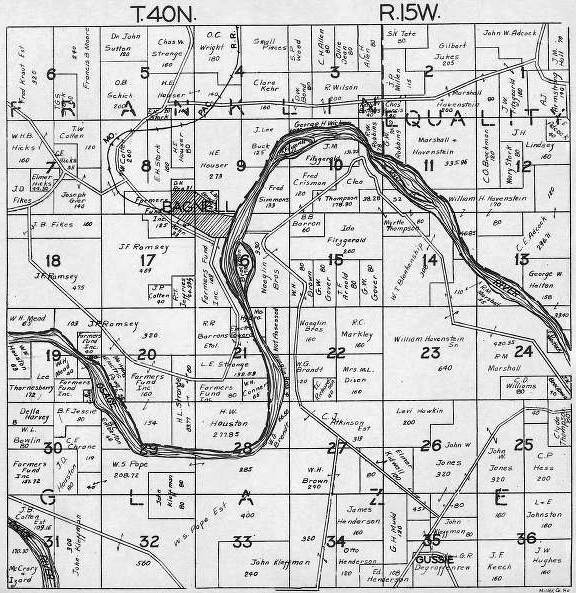
12 Plat Map: T40N - R15W Gaylord also told me that his mother’s grandmother, Mrs. William Conner, was said to have been buried where the Osage National Clubhouse now is located. Apparently, the tombstone was misplaced as he told me he never was able to be sure where the grave was located.
According to an article in the Eldon Advertiser written by Amber Shackleford after interviewing Gaylord several years ago, he told her he worked on the Dam construction himself. He was the 53rd employee hired and “the first one injured!” It happened on his sixteenth birthday!
“I just cut a place in my toe,” Gaylord told her. “Mr. Jessup, the superintendent of the construction of the dam, took me to Bagnell where Dr. Shirley put four stitches in it.” Gaylord said he was swinging an axe and he just missed and hit his toe. After the injury, he was off work for a week. When he returned, he “was given a different job!”
Here is an old photo of Gaylord’s father’s family (photo 13):
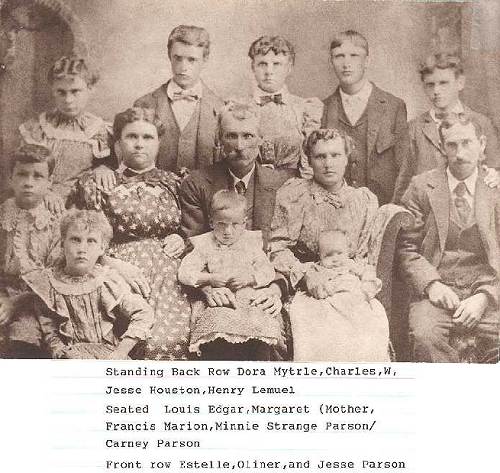
13 Strange Family Portrait
Click image for larger viewGaylord was one of the local Bagnell natives who was one of our favorite historians. We miss him very much!
On display in our museum is a portable makeup kit of the kind used by entertainers or other professional women who travelled frequently dating back to the 1930’s (photo 14).
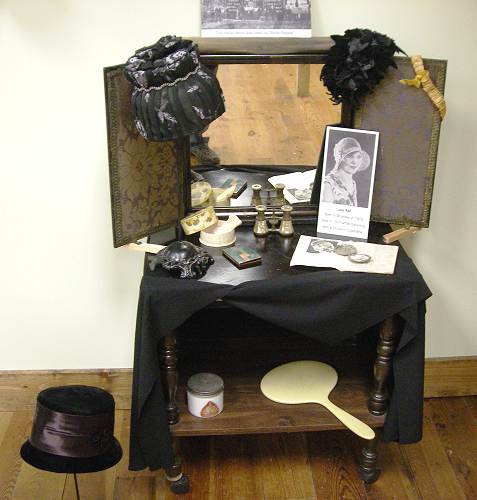
14 Portable Make Up Kit As part of the display is a photo of a Miller County lady, Lois Ash, who at one time was said to have worked with a traveling show (photo 15).
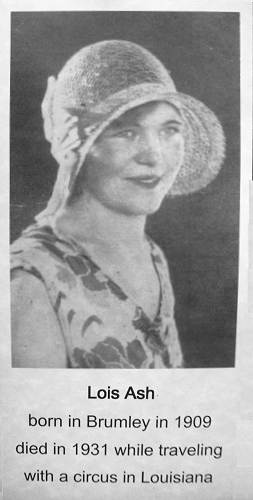
15 Lois Ash The story that came with the photo said she “died in 1931 while traveling with a circus in Louisiana” (photo 16).
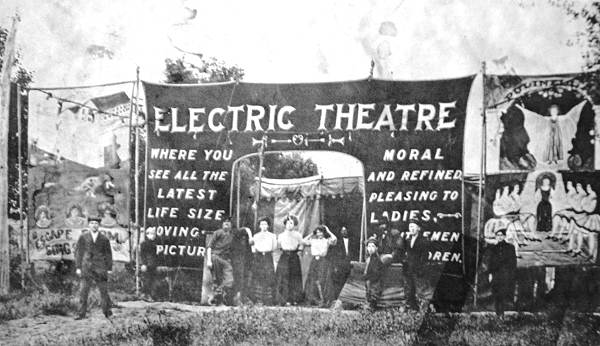
16 Traveling Show I checked around and called a few people including a Tuscumbia school graduate acquaintance, Farris Ash, but couldn’t find out the details of the reason she died so young (she was born in 1909). One reason information is difficult to obtain is that she and her family left the area to live in Pacific, Missouri.
However, I did find some interesting history at this Ancestry.com website.
Although the website concentrates on genealogical data I was able to put together from the site a summary of her family and something about her death.
The following was written by Marcine Lohman, who is the Ash family genealogist responsible for the above website detailing the Ash genealogical tree:
“Greenberry Ash was born in 1874 in Brumley, Mo. He married Nancy Ann Mahala Thornton in 1900 in Iberia, Missouri. Nancy was born in 1874 in Beardstown, Illinois and was the daughter of George Thornton and Polly Luttrell.
Green Berry first shows up in the 1880 Miller County Census records (Glaize Township) indicating that he was 5 years old and his father was born in North Carolina.
My mother told me an interesting tidbit about Green Ash. It seems that he was a bit of a "mama's boy" and even after he had married Nancy Thornton, he didn't stay at their house all the time. He'd go back home and stay with his mother, Elizabeth Ash. Elizabeth had inherited a lot of land from her father, Samuel Ash, and all her children had houses built on her land so none of them lived far away. Green had several half brothers, my mom 'thinks' there might have been six in all, but he was apparently his mother's favorite. Although Green didn't seem to show any interest in working, his wife Nancy would cut railroad ties to make money for the family. She said it was easier work than ironing and cleaning for other people which was her other option. It is rumored that Green's brothers burned down his house in order to drive him away from the area. At least that was what Green had always thought. After his house burned down, Green and Nancy moved to Sullivan and finally to Pacific, Missouri in Franklin County. While in Pacific, Green worked for the railroad.
Nancy Ash had a unique gift and would read the grains of tea or coffee left in the bottom of a glass and had, on several occasions, predicted someone's death. On one occasion, Nancy saw stars falling and ran into the house. Upon everyone reassuring her that the stars were indeed NOT falling, she told them that someone in her family was going to die. Her son, Leonard, fell under a train and was killed at the gravel plant where he worked. This happened at the old gravel plant in Pacific across from the Pennsylvania Glass and Sand plant where my dad, Andrew Amelung, worked (on Osage Street just east of town near where the old ice plant stood).
Her daughter, Marcella, seemed to have the same gift as she had a premonition about Lois' (Lois Ash) fiancée many years earlier and asked him not to go to work. He was run over by a train at the very same gravel plant where Leonard was run over. Marcella had also seen or dreamt strange things the night before a death including her husband's death and her sister's.
I've spoken with one other currently living relative who also has this same gift.
Children of Green Ash and Nancy Thornton are:
i Everett Oliver Ash
ii. Felix Lonnie Ash
iii. Leonard Mason Ash
iv. Lee Roy Ash, Sr
v. Dealey Lois Ash
vi. Marcella May Ash
My mother has told me some interesting tidbits about Marcella and her mother Nancy Ash. Both seemed to have premonitions when someone close was going to die. For instance, Marcella, knew when her sister, Lois, had died, she had dreamt that she saw her sister on a cloud waving goodbye to her and then she disappeared. Marcella found out the next day that her sister had indeed died from food poisoning, although the family believed otherwise. Rumors were that she was poisoned since her husband wanted to marry another girl, who by the way, he married two weeks later. On an earlier occasion, Marcella had warned her sister Lois' fiancée not to go to work one day. She just had a feeling something bad was going to happen. He was also run over by a train while crossing the tracks at the Gravel Plant where he also worked. This was the same place where their brother Leonard had been run over by a train. The last known premonition was when Marcella had seen a man standing in a doorway wearing very old style knickers. Upon mentioning it to her husband, Jesse Moege, he saw nothing and when she turned back, the man was gone. Her husband died the next day.
My mother also mentioned a story that Marcella told her not long before she died when my mother and aunt went up to visit her. It seems that when Marcella was a little girl and her mother made a fire to make lye soap (they used a big pot and cooked it outside), Marcella would start dancing around the fire and chanting. Nancy finally prayed to God that if she went to church could he please make Marcella stop doing this. Well, she became a church-goer and sure enough, Marcella stopped and never did it ever again.”
Now I don’t know how reliable this story is; however, it originates with an Ash family genealogist. So, could it be that Lois Ash was poisoned by her husband while touring with a circus in Louisiana? I emailed the person named above who wrote the summary and did the genealogical tabulation found on the website but the email was not accepted so I couldn’t ask any follow-up questions. Maybe some readers of this website could tell us more about Lois Ash’s story.
The C.B. Wright diary entry for this week is from July and August of 1912. C.B. once again describes events occurring related to his steamboat travels up and down the Osage River. The photo of Clarence pictured this week is from a time when he was very young (photo 17).
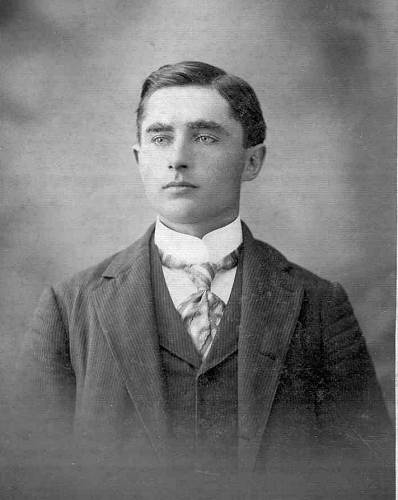
17 Clarence Wright I have several photos of C.B. which I copied from the collection of Janet Hix Buthold. She is the daughter of Ida Hauenstein Hix, who was a sister to C.B.’s wife, May Hauenstein Wright. Of the several river stops he mentions this week one was near the mouth of the Bois Bruhle Creek (Clarence omits the silent “h”). As were many of the creeks in the area several were named by the earliest explorers, trappers who were from France. Bois Bruhle is a creek in Cole County. Its headwaters begin near the Miller County and Cole County line on Highway 54. It flows eastward toward the Osage where it empties into her waters approximately 2 1/2 miles due west of present-day St. Thomas. Very early on, as the white men came to this area, the Indian canoe was superseded by the flatboat. This was back in the early 1800s. Early Frenchmen who explored Miller County, coming up the river in flatboats, left indelible proof of their visit by such names as the Bois Bruhle Creek, the Tavern, Gravois, Auglaize and many others. As the frontiersmen pushed up the Missouri and the Osage and settlements began to spring up along the Osage, flatboats became the chief means of bringing merchandise into the country and in taking out the products. These flatboats were something like 100 feet in length and sometimes six or more of these could be seen at one time at the Tuscumbia landing.
Another item of interest is C.B.’s use of the name “Charlestown,” the original name of St. Elizabeth.
According to Dale Doerhoff, author of the book “A Trip To Charleytown,” Owen Riggs was the original landowner where the town of St. Elizabeth first was located, near the Osage River. This is where the first Miller County Catholic Church was built in 1870 (photo 18).
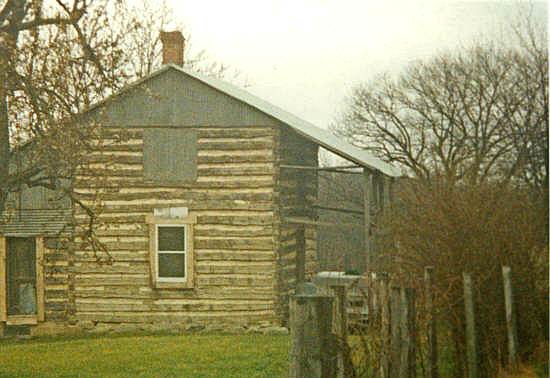
18 First Catholic Church in Miller County Because of some unwise decisions Riggs found himself in financial trouble. A Westphalia merchant, Charles Holtschneider, originally had backed Riggs so he took possession of nearly 6,000 acres of land Riggs held. This included the original land near the river where was located the first St. Elizabeth as well as the area now occupied by present day St. Elizabeth. Holtschneider donated the lot where the present church and rectory are.
In honor of Charles Holtschneider the local residents named their community “Charlestown.” However, many people began to refer to the town by a diminutive, "Charleytown,” in reference to the official name. Charlestown was incorporated as a village on May 24, 1948. It was not until June 5, 1961, that the town became officially St. Elizabeth when the change was approved by the Missouri Secretary of State.
I can remember as a young boy growing up in Tuscumbia that local people still commonly referred to St. Elizabeth as “Charleytown.” But I haven’t heard that name used now for many years.
Many other interesting stories of St. Elizabeth can be found in Dale Doerhoff’s book mentioned above and I highly recommend it. Dale (photo 19) is the son of Leonard and Cyrilla Doerhoff of St. Elizabeth and has written several articles about his home town over the years for the Autogram and Advertiser newspapers. He is an attorney whose office is located in Columbia, Missouri.

19 Dale Doerhoff Another reference made by C.B. was the stop at “Klug’s” on an excursion run with ninety passengers. William Klug was born in Germany and came to America when a young man. He was a soldier in the Franco-Prussian War, and it was shortly after the war that he decided to come to America.
He was well known to Miller County people and a great many came from a distance for picnics on his farm on the Osage River, near Mary’s Home. The farm was noted for its scenic beauty with its springs and huge bluffs. In addition, Mr. Klug made his living largely by fishing, and great numbers of people went there annually to have a feast of fish. He died in 1926 and was buried in the Mary’s Home Cemetery (photo 20).
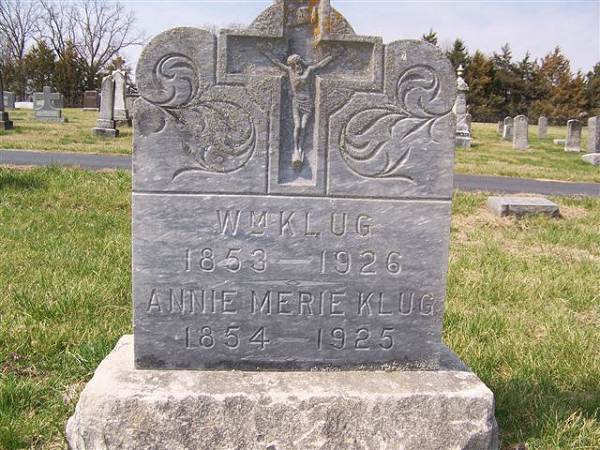
20 William and Annie Klug Headstone One of William’s sons was John Klug who lived in Tuscumbia (photo 21).
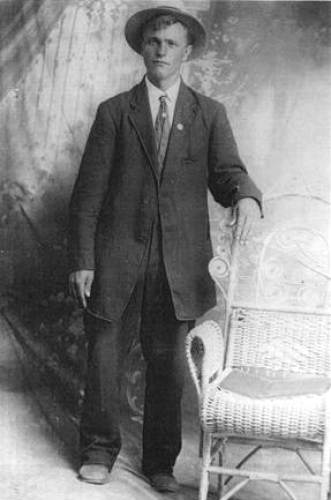
21 John Klug He was a blacksmith but his main source of income when I knew him was to run a truck from Tuscumbia to St. Louis carrying livestock. He was married to Eva McNeely (photo 22).
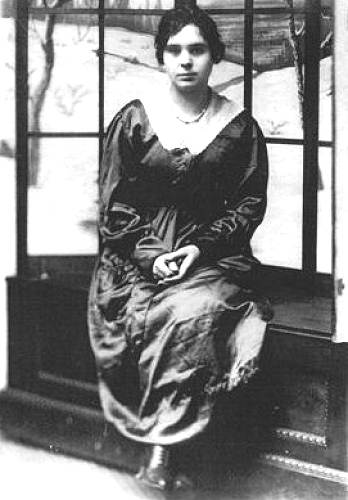
22 Eva McNeely Klug
That’s all for this week.
 Joe Pryor
|



